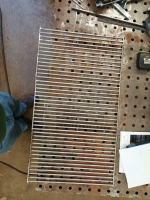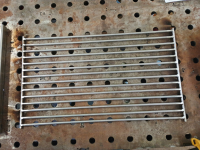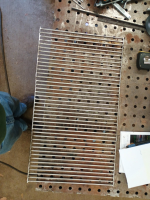You are using an out of date browser. It may not display this or other websites correctly.
You should upgrade or use an alternative browser.
You should upgrade or use an alternative browser.
Home built stainless grates
- Thread starter JKalchik
- Start date
I'm the wrong guy to ask, probably. If I terminate a weld properly by releasing the trigger and pulling back, I'll go on to the next weld and continue. If I have a short, a burn-back, or something else, then I'll probably extend the wire and trim to the proper stick-out.And now for the big question...do you cut the little ball off the end of the wire each time before you start a weld? I got into the habit of doing that while working with a welder at Generous Electric. Some people do, some don't, always good for an argument!
Ed P
TVWBB Honor Circle
Welding is 20% theory and 80% under-the-hood time. The biggest thing to know is that MIG doesn't get anywhere near the penetration of an arc weld so material prep is a must. Remove the paint and vee out thicker sections (over 1/8th inch or so). MIG welding is used extensively in sheet metal and auto body shops.<snicker> If you can weld with a stick, you'll find MIG to be easy.
Ed P
TVWBB Honor Circle
I worked with a guy at GE doing the welding. Nobody else wanted to weld...it was too hot, dirty, sweaty, so Zeke (from Cabin Creek) and I did it. We both enjoy welding. Anyway, one of the engineers had a bunch of rolling racks made for the jet engine rebuilders and had them powder coated, but made a miscalculation and the parts wouldn't fit on the shelves. We had to rework a bunch of them, grinding off the welds and re-positioning the shelves. The powder coating has to come off to MIG weld...what a mess. That stuff is like a plastic coating that doesn't sand off well but kind of melts and smears. We should have used an arc welder.I'm the wrong guy to ask, probably. If I terminate a weld properly by releasing the trigger and pulling back, I'll go on to the next weld and continue. If I have a short, a burn-back, or something else, then I'll probably extend the wire and trim to the proper stick-out.
To pick a nit..... MIG *IS* an arc process, using a gas shield. You're referring to stick, with a powdered flux that generates the shielding gas.The biggest thing to know is that MIG doesn't get anywhere near the penetration of an arc weld
BTW, my welder with .045 wire and cranked up to the KILL setting burned in 1/2" plate for the smoker firebox in a single pass. Backside was showing plastic state, lots of weaving, and a very hot gun at the end.
Well.... not really, IMO. Those grates definitely have their warts, but for me, they're just fine.That's insanely impressive!
Just for a little education.......
Welding is a high heat process that joins similar metals using a similar metal as a filler. In this process, both the filler and the work pieces melt together into a weld puddle.
Brazing is another way to join metals, but is a lower heat process than welding, and doesn't melt the work pieces. The filler is melted and adheres to the work pieces. Fillers used on steel are brass or bronze bases, and may or may not be flux coated. The heat source can be an electric arc, or more commonly, an oxygen-acetylene torch.
Soldering is a low temperature process that is primarily used for electrical connections, and is really not structural in usage. The filler is a low temp lead alloy, and the work pieces do not melt.
Shielded Metal Arc Welding, aka SMAW, aka stick. This is an electrical process that uses a sacrificial electrode that's coated with a powdered flux that sublimates under the heat of the electric arc. The electrode or stick is gripped by a holder wielded by the operator. The work piece is grounded back to the power source to complete the arc. When an arc is struck between the electrode and the work piece, the flux turns into a shielding gas to prevent oxidation as the electrode and work pieces melt and flow together. This is one of the original electrical processes used to join metal. It's useful on work pieces that are corroded, or in breezy to windy conditions. Each electrode stick is good for a couple of minutes to a few minutes of time and several inches to feet of welding before being exhausted and has to be replaced. This process also leaves slag on top of the weld that should be chipped off with a slag hammer or similar method.
Gas Metal Arc Welding, aka GMAW, aka Metal Inert Gas, aka MIG. Also an electric process, the work piece is grounded back to the power source. The gun, also known as a stinger, is connected to the power source by a whip that conducts electricity to the gun electrode (or contact tip,) a wire filler from a spook, as well as a shielding gas flow. The electric circuit is energized when the gun tripper is pulled, engages the drive rollers that push the wire through the whip to the spool, and opens a gas valve to provide the flux gas. This process has the advantage over stick welding in that the filler is effectively infinite in nature until the spool runs out. It also does not leave a slag coating on top of the weld. Preparation is important for the join, the pieces do need to fit closely together with as small of a gap as reasonably possible, clean of any contaminants like oil and paint, and a breeze free environment.
Gas Tungsten Arc Welding, aka GTAW, aka Tungsten Inert Gas, aka TIG. This is another electric process, but unlike SMAW and GMAW, the electrode is not a sacrificial filler. The work piece is again grounded back to the power source, and the gun now delivers electricity and shielding gas to a tungsten electrode. Tungsten is generally used in a variety of different alloys due to it's high melt point. The operator will trigger power and gas flow by a foot pedal or a gun trigger. Unlike a GMAW gun which is either on or off, a GTAW trigger is variable at the operator's desire. When the arc is struck and the work pieces begin melting into the puddle, the operator will feed by hand a filler into the weld puddle to add additional material as necessary. As the flux is gas, there's no slag left on top of the weld. Like GMAW/MIG, the work needs to be fitted up well, clean, and a breeze free environment.
All 3 of the processes can be alternating current, or direct current. If the power source is DC, the direction of the arc flow is important as that will determine where the majority of the heat in the arc is, i.e. in the work piece, or the filler, depending on which the operator wants to melt more.
There are a large variety of other processes available for very specific use cases, like spin welding, laser welding (think GTAW, but using a laser as a heat source instead of an electric arc,) and a lot more.
Nearly every farm I've ever set foot on has what's referred to as a tombstone welder, due to it's resemblance to a tombstone, and it's economy. As it's a SMAW/stick welder, it'll get used for rusty equipment repair and out in the wind. These days, bigger and better welders are becoming more common place. In addition to the tombstone welder that's on the farm where I grew up for 50+ years, my brother has a big GMAW/MIG and GTAW/TIG welder for big fabrication projects.
As far as a lot of the activities here on the TVWBB...... this is more for academic curiosity than anything. GMAW/MIG or GTAW/TIG can be used to weld in new pieces of tubing, or even potentially repair fractured aluminum (that's a rather advanced topic.)
All of this is a huge oversimplification of general welding processes. The Internet has a lot of far better resources than I if you're interested in more, and youtube and other video sites will have some good material as well. Your local community college may also have classes.
Final notes: SAFETY
There's a lot of grinding and other prep that will potentially involve flying grit. Good close fitting shop glasses are a must, IMO. Photosensitive prescription eyeglasses will darken around a welding arc, even behind a welding helmet.
Get a good welding helmet. I do like an auto-darkening helmet, but I learned stick welding with nothing more than a fixed #11 helmet. However, be aware that economy helmets have been known to either not darken fast enough when an arc is struck, or lighten if the single sensor is occluded.
Gloves. Hot metal. Don't think I need to say more.
Clothes. NOTHING SYNTHETIC. Leather is ideal, but non-flammable material can be acceptable. I have a set of impermiable sleeves with elbow patches that are handy.
Be very very careful welding in an enclosed space, especially stainless, and other sort of uncommon materials. Heavy metal poisoning is a possibility.
Welding is a high heat process that joins similar metals using a similar metal as a filler. In this process, both the filler and the work pieces melt together into a weld puddle.
Brazing is another way to join metals, but is a lower heat process than welding, and doesn't melt the work pieces. The filler is melted and adheres to the work pieces. Fillers used on steel are brass or bronze bases, and may or may not be flux coated. The heat source can be an electric arc, or more commonly, an oxygen-acetylene torch.
Soldering is a low temperature process that is primarily used for electrical connections, and is really not structural in usage. The filler is a low temp lead alloy, and the work pieces do not melt.
Shielded Metal Arc Welding, aka SMAW, aka stick. This is an electrical process that uses a sacrificial electrode that's coated with a powdered flux that sublimates under the heat of the electric arc. The electrode or stick is gripped by a holder wielded by the operator. The work piece is grounded back to the power source to complete the arc. When an arc is struck between the electrode and the work piece, the flux turns into a shielding gas to prevent oxidation as the electrode and work pieces melt and flow together. This is one of the original electrical processes used to join metal. It's useful on work pieces that are corroded, or in breezy to windy conditions. Each electrode stick is good for a couple of minutes to a few minutes of time and several inches to feet of welding before being exhausted and has to be replaced. This process also leaves slag on top of the weld that should be chipped off with a slag hammer or similar method.
Gas Metal Arc Welding, aka GMAW, aka Metal Inert Gas, aka MIG. Also an electric process, the work piece is grounded back to the power source. The gun, also known as a stinger, is connected to the power source by a whip that conducts electricity to the gun electrode (or contact tip,) a wire filler from a spook, as well as a shielding gas flow. The electric circuit is energized when the gun tripper is pulled, engages the drive rollers that push the wire through the whip to the spool, and opens a gas valve to provide the flux gas. This process has the advantage over stick welding in that the filler is effectively infinite in nature until the spool runs out. It also does not leave a slag coating on top of the weld. Preparation is important for the join, the pieces do need to fit closely together with as small of a gap as reasonably possible, clean of any contaminants like oil and paint, and a breeze free environment.
Gas Tungsten Arc Welding, aka GTAW, aka Tungsten Inert Gas, aka TIG. This is another electric process, but unlike SMAW and GMAW, the electrode is not a sacrificial filler. The work piece is again grounded back to the power source, and the gun now delivers electricity and shielding gas to a tungsten electrode. Tungsten is generally used in a variety of different alloys due to it's high melt point. The operator will trigger power and gas flow by a foot pedal or a gun trigger. Unlike a GMAW gun which is either on or off, a GTAW trigger is variable at the operator's desire. When the arc is struck and the work pieces begin melting into the puddle, the operator will feed by hand a filler into the weld puddle to add additional material as necessary. As the flux is gas, there's no slag left on top of the weld. Like GMAW/MIG, the work needs to be fitted up well, clean, and a breeze free environment.
All 3 of the processes can be alternating current, or direct current. If the power source is DC, the direction of the arc flow is important as that will determine where the majority of the heat in the arc is, i.e. in the work piece, or the filler, depending on which the operator wants to melt more.
There are a large variety of other processes available for very specific use cases, like spin welding, laser welding (think GTAW, but using a laser as a heat source instead of an electric arc,) and a lot more.
Nearly every farm I've ever set foot on has what's referred to as a tombstone welder, due to it's resemblance to a tombstone, and it's economy. As it's a SMAW/stick welder, it'll get used for rusty equipment repair and out in the wind. These days, bigger and better welders are becoming more common place. In addition to the tombstone welder that's on the farm where I grew up for 50+ years, my brother has a big GMAW/MIG and GTAW/TIG welder for big fabrication projects.
As far as a lot of the activities here on the TVWBB...... this is more for academic curiosity than anything. GMAW/MIG or GTAW/TIG can be used to weld in new pieces of tubing, or even potentially repair fractured aluminum (that's a rather advanced topic.)
All of this is a huge oversimplification of general welding processes. The Internet has a lot of far better resources than I if you're interested in more, and youtube and other video sites will have some good material as well. Your local community college may also have classes.
Final notes: SAFETY
There's a lot of grinding and other prep that will potentially involve flying grit. Good close fitting shop glasses are a must, IMO. Photosensitive prescription eyeglasses will darken around a welding arc, even behind a welding helmet.
Get a good welding helmet. I do like an auto-darkening helmet, but I learned stick welding with nothing more than a fixed #11 helmet. However, be aware that economy helmets have been known to either not darken fast enough when an arc is struck, or lighten if the single sensor is occluded.
Gloves. Hot metal. Don't think I need to say more.
Clothes. NOTHING SYNTHETIC. Leather is ideal, but non-flammable material can be acceptable. I have a set of impermiable sleeves with elbow patches that are handy.
Be very very careful welding in an enclosed space, especially stainless, and other sort of uncommon materials. Heavy metal poisoning is a possibility.
Last edited:
Eric-NH
TVWBB All-Star
I meant the overall process. Maybe they aren't ready for "prime time" but they look great and the fact that you made them is extra cool. Well doneWell.... not really, IMO. Those grates definitely have their warts, but for me, they're just fine.
<PaulHarvey>And now...... for the rest of the story.</PaulHarvey>
I am officially happy with how these grates cook. They do heat up quickly (about 5 minutes from cold to cook temp or less,) and I get some good searing, nothing sticks. The grates scrape clean quickly with a stainless scrubby, and once heated up over the charcoal, swabbed down with paper towel with a little vegetable oil.
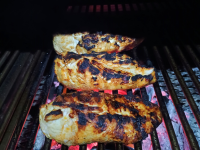
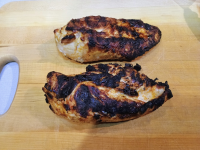
Chicken fajitas. These are some rather large and thick pieces of boneless breast, they did take 20 minutes more or less to fully cook through.
I am officially happy with how these grates cook. They do heat up quickly (about 5 minutes from cold to cook temp or less,) and I get some good searing, nothing sticks. The grates scrape clean quickly with a stainless scrubby, and once heated up over the charcoal, swabbed down with paper towel with a little vegetable oil.


Chicken fajitas. These are some rather large and thick pieces of boneless breast, they did take 20 minutes more or less to fully cook through.
And bringing this back around again on the guitar.... (with apologies to Arlo Guthrie.....)Edit: I have a TIG/stick welder (ThermalArc 186, I think....) just can't quite seem to get my head wrapped around the TIG process.
I am apparently an idiot, but a bit of a trainable idiot. My TIG welder got set up for DC electrode positive, which just generally ain't right for most steel welding. I finally flipped the polarity around, and it's a completely different process. With DC +, I had horrible problems with electrodes melting and balling up, and just never getting penetration into the work. DC - turns the heat around, electron flow is from the tungsten into the work, and most of the heat ends up in the work where it belongs. I'm able to weld 1/4" 304 stainless round stock in a Tee joint without filler, and without overheating the work pieces either.
I knew I had to be doing something wrong, and grossly wrong at this. This is one of the fundamentals that you just don't violate as a rule.
Open ended question time.
First, a few caveats.
I can only get SAE/Imperial sized stock, i.e. 1/4", 3/8", etc., and in 304 grade. That'd be 6.35mm and 9.525mm.
I am very much a self-taught welder, always improving.
I'm set up for MIG and TIG process, far better with a MIG gun than a TIG torch
I have jigs for 1/2" gaps in both 1/4" and 3/8" stock, I'm probably going to see if I can have the machinist make a a set of jigs for both stock sizes in 3/8" spacing.
I'm really only able to make rectangular grates at this point, I don't have a ring roller (that may change,) and I'm not quite ready to deal with the fussiness of varying rod lengths for round grates.
I have a fair powered band saw and can cut to a reasonably accurate lenghth over a job, as well as a rotary chamfer tool to deburr the ends.
Given the above, what would you want in a grate? Rod size? spacing? Rough dimensions?
Oh, and I am absolutely not trying to compete with Dave aka rcplanebuyer. He's much better at this than I m.
First, a few caveats.
I can only get SAE/Imperial sized stock, i.e. 1/4", 3/8", etc., and in 304 grade. That'd be 6.35mm and 9.525mm.
I am very much a self-taught welder, always improving.
I'm set up for MIG and TIG process, far better with a MIG gun than a TIG torch
I have jigs for 1/2" gaps in both 1/4" and 3/8" stock, I'm probably going to see if I can have the machinist make a a set of jigs for both stock sizes in 3/8" spacing.
I'm really only able to make rectangular grates at this point, I don't have a ring roller (that may change,) and I'm not quite ready to deal with the fussiness of varying rod lengths for round grates.
I have a fair powered band saw and can cut to a reasonably accurate lenghth over a job, as well as a rotary chamfer tool to deburr the ends.
Given the above, what would you want in a grate? Rod size? spacing? Rough dimensions?
Oh, and I am absolutely not trying to compete with Dave aka rcplanebuyer. He's much better at this than I m.
Josh Dekubber
TVWBB Hall of Fame
I think 3/8 rods with 3/8 spacing is the sweet spot. Which is what the Weber #9930s are and Dave's which are virtually identical. I can't tell the difference. That's just my opinion. I don't think that if the bar was any bigger or the spacing any tighter that I would prefer it anymore than 9930s or Dave's.Given the above, what would you want in a grate? Rod size? spacing? Rough dimensions?
Wilmer Cogburn
TVWBB Super Fan
When I make new grates for my Wolf this is what I will do.I think 3/8 rods with 3/8 spacing is the sweet spot. Which is what the Weber #9930s are and Dave's which are virtually identical. I can't tell the difference. That's just my opinion. I don't think that if the bar was any bigger or the spacing any tighter that I would prefer it anymore than 9930s or Dave's.
Cody Bratton
TVWBB Platinum Member
I finally got my paws on some of those heavy 9930’s  they are incredible. I may even just abandon all other projects and get them cleaned up today
they are incredible. I may even just abandon all other projects and get them cleaned up today 

